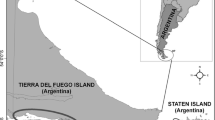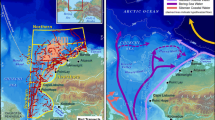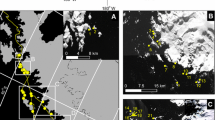Abstract
Our long-term study on top predator (seabirds and marine mammals) distribution in polar marine ecosystems aims at detecting possible temporal and spatial population changes, especially in the context of global changes in temperature and ice cover. Quantitative data on the seabird distribution were collected in the northern Greenland Sea and Fram Strait onboard the icebreaker RV Polarstern between 1988 and 2014, applying 30-min transect counts from the bridge, without width limitation (n = 7320). A drastic decrease in numbers by a factor of seven was detected for the ivory gull Pagophila eburnea from 2007 on. These data confirm the decrease of ivory gull previously detected in North Canada and North Greenland, leading to the conclusion that the species is “endangered” or “near threatened”. These changes are discussed in relation to the decreasing Arctic pack ice coverage leading to the opening of the Northwest and Northeast Passages in 2007, at the time the year with the lowest ice coverage ever recorded. On the other hand, the decrease was even stronger for Ross’s gull Rhodostethia rosea after 1993, apparently reflecting changes in migratory habits. The third high Arctic gull, Sabine’s gull Xema sabini, was only tallied in very low numbers, without any clear temporal evolution in numbers.

Similar content being viewed by others
References
BirdLife International (2015) Pagophila eburnea. The IUCN Red List of Threatened Species Version 2015.2. http://www.iucnredlist.org
Birkenmajer K (1969) Observation on Ivory Gull, Pagophila eburnea (PHIPPS), in south Vestspisbergen. Acta Ornitho XI:461–476 (in Polish with English summary)
Blomqvist S, Elander M (1981) Sabine’s gull (Xema sabini), Ross’s gull (Rhodostethia rosea) and ivory gull (Pagophila eburnea). Gulls in the Arctic: a review. Arctic 34:122–132. doi:10.14430/arctic2513
Boertmann D, Olsen K, Gilg O (2010) Ivory gull colony on ice floe. Polar Rec 46:86–88
Brown RGB (1984) Seabirds in the Greenland, Barents and Norwegian seas, February–April 1982. Polar Res 2:1–18
Chardine JW, Fontaine AJ, Blokpoel H, Mallory M, Hofmann T (2004) At-sea observations of ivory gulls (Pagophila eburnea) in the eastern Canadian high Arctic in 1993 and 2002 indicate a population decline. Polar Rec 40:355–359
COSEWIC (2006) COSEWIC assessment and update status report on Ivory Gull (Pagophila eburnea) in Canada. Committee on the Status of Endangered Wildlife in Canada, Ottawa
Cramp S, Simmons KEL (eds) (1983) Handbook of the birds of Europe. In: The middle east and north Africa, vol. III. Oxford University Press
Decker MB, Gavrilo M, Mehlum F, Bakken V (1998) Distribution and abundance of birds and marine mammals in the Eastern Barents Sea and the Kara Sea, late summer 1995. Nor Polarinst, Meddelelser n°155, Oslo
Dement’ev GP, Gladkov NA (eds) (1969) Birds of the Soviet Union. In: Israel program for scientific translations, vol. III, Jerusalem
Eamer J, Donaldson GM, Gaston AJ, Kosobokova KN, Lárusson KF, Melnikov IA, Reist JD, Richardson E, Staples L, von Quillfeldt CH (2013) Life Linked to Ice: A guide to sea-ice-associated biodiversity in this time of rapid change. CAFF Assessment Series No. 10. Conservation of Arctic Flora and Fauna, Akureyri, Iceland. 116 ps
Egevang C, Boertmann D (2008) Ross’s gulls (Rhodostethia rosea) breeding in Greenland: a review, with special emphasis on records from 1979 to 2007. Arctic 61:322–328
Gaston AJ, Mallory ML, Gilchrist HG (2012) Populations and trends of Canadian Arctic seabirds. Polar Biol 35:1221–1232. doi:10.1007/s00300-012-1168-5
Gavrilo M (2009) Breeding distribution of ivory gull in the Russian Arctic: difficulty when studying range of a rare and sporadically breeding high arctic species. Problemy Arktiki and Antarktiki Iss 3(82):127–151 (In Russian, English translation available)
Gavrilo MV (2011) Ivory gull Pagophila eburnea (Phipps, 1774) in the Russian Arctic: breeding patterns of species within the current species range optimum. Thesis abstract. Ph.D. thesis, Saint Petersburg, Russia (in Russian)
Gilchrist HG, Mallory ML (2005) Declines in abundance and distribution of the ivory gull (Pagophila eburnea) in Arctic Canada. Biol Conserv 121:303–309
Gilchrist G, Strøm H, Gavrilo MV, Mosbech A (2008) International ivory gull conservation strategy and action plan. CAFF technical report no. 18. Conservation of Arctic Flora and Fauna (CAFF) International Secretariat, Circumpolar Seabird Group (CBird), Akureyri, Iceland
Gilg O, Boertmann D, Merkel F, Aebischer A, Sabard B (2009) Status of the endangered ivory gull, Pagophila eburnea, in Greenland. Polar Biol 32:1275–1286. doi:10.1007/s00300-009-0623-4
Gilg O, Strøm H, Aebischer A, Gavrilo MV, Volkov AE, Miljeteig C, Sabard B (2010) Post-breeding movements of northeast Atlantic ivory gull Pagophila eburnean populations. J Avian Biol 41:532–542. doi:10.1111/j.1600_048X.2020.05125x
Gilg O, Andreev A, Aebischer A, Kondratyev A, Sokolov A, Dixon A (2016) Satellite tracking of Ross’s gull Rhodostethia rosea in the Arctic Ocean. J Ornithol 157:249–253. doi:10.1007/s10336-015-1273-7
Hjort C, Hakansson E, Stemmerik L (1983) Bird observations around the Nordostvandet [North-East Water] polynya, Northeast Greenland, 1980. Dansk Orn Foren Tidsskr 77:107–114
Joiris CR (1992) Summer distribution and ecological role of seabirds and marine mammals in the Norwegian and Greenland seas (June 1988). J Mar Syst 3:73–89
Joiris CR (1996) At-sea distribution of seabirds and marine mammals around Svalbard, summer 1991. Polar Biol 16:423–429. doi:10.1007/BF02390424
Joiris CR (2007) At-sea distribution of seabirds and marine mammals in the Greenland and Norwegian seas: impact of extremely low ice coverage. Symposium on European Research on Polar Environments and Climate, Brussels, 5–6 March 2007. http://ec.europa.eu/research/environment/newsanddoc/agenda0307_en.htm
Joiris CR (2011) A major feeding ground for cetaceans and seabirds in the south-western Greenland Sea. Polar Biol 34:1597–1607. doi:10.1007/s00300-011-1022-1
Joiris CR (2012) Possible impact of decreasing Arctic pack ice on the higher trophic levels—seabirds and marine mammals. Adv Environ Res 23:207–221
Joiris CR, Falck E (2011) Summer at-sea distribution of little auks Alle alle and harp seals Pagophilus (Phoca) groenlandica in the Greenland Sea: impact of small-scale hydrological events. Polar Biol 34:541–548. doi:10.1007/s00300-010-0910-0
Joiris CR, Tahon J (1992) Distribution and food intake of seabirds and marine mammals in the Norwegian and Greenland seas (July 1988). Royal Acad Overseas Sc, Brussels, pp 113–133
Joiris CR, Tahon J, Holsbeek L, Vancauwenberghe M (1996) Seabirds and marine mammals in the eastern Barents Sea: late summer at-sea distribution and calculated food intake. Polar Biol 16:245–256. doi:10.1007/s003000050051
Joiris CR, Kampp K, Tahon J, Møbjerg Kristensen R (1997) Summer distribution of seabirds in the North-East Water polynya, Greenland. J Mar Syst 13:51–59
Joiris CR, Falck E, D’Hert D, Jungblut S, Boos K (2014) An important late summer aggregation of fin whales Balaenoptera physalus, little auks Alle alle and Brünnich’s guillemots Uria lomvia in the eastern Greenland Sea and Fram Strait: influence of hydrographic structures. Polar Biol 37:1645–1657. doi:10.1007/s00300-014-1551-5
Joiris CR, Boos K, D’Hert D, Nachtsheim DA (2016) Low density of top predators—seabirds and marine mammals—in the high Arctic pack ice. Scientifica (Marine Biology) in press
Karnovsky NJ, Hobson KA, Brown ZW, Hunt GL Jr (2009) Distribution and diet of ivory gulls (Pagophila eburnea) in the North Water Polynya. Arctic 62:65–74
Kondratyev AYa, Litvinenko NM, Kaiser GW eds (2000) Seabirds of the Russian Far East. Special publication, Canadian Wildl Serv
MacDonald SD, Macpherson AH (1962) Breeding places of the ivory gull in Arctic Canada. Natl Mus Can Bull 183:111–117
Maftei M, Davis SE, Uher-Koch BD, Gesmundo C, Suydam R, Mallory ML (2014) Quantifying fall migration of Ross’s gulls (Rhodostethia rosea) past Point Barrow, Alaska. Polar Biol 37:1705–1710
Mallen Olsen K, Larsson H (2003) Gulls of Europe, Asia and North America. C Helm ed. 608 ps
Mallory ML, Gilchrist HG, Fontaine AJ, Akearok JA (2003) Local ecological knowledge of ivory gull declines in Arctic Canada. Arctic 56:293–298
Mehlum F (1989) Summer distribution of seabirds in northern Greenland and Barents seas. Nor Polarinst Skr 191:1–56
Meltofte H (1972) Ornithological observations in the Norwegian Sea, the Greenland Sea, and NE Greenland, July–August 1972. Dansk Orn Foren Tidsskr 66:108–112
Murdoch J (1899) A historical notice of Ross’s rosy gull (Rhodostethia rosea). Auk 16:146–155. doi:10.2307/4069547
Nachtsheim DA, Joiris CR, D’Hert D (2015) A gravel-covered iceberg provides an offshore breeding site for ivory gulls Pagophila eburnea off Northeast Greenland. Polar Biol 39(2016):755–758. doi:10.1007/s00300-015-1824-7
Spencer NC, Gilchrist HG, Mallory ML (2014) Annual movement patterns of endangered ivory gulls: the importance of sea ice. PLoS ONE. doi:10.1371/journal.pone.0115231
Acknowledgments
We are very grateful to the Alfred Wegener Institute (AWI), Bremerhaven, and the late coordinator, E. Fahrbach, for kind invitations onboard the icebreaker R.V. Polarstern from 1988 till 2014; observers were C.J. and many PolE members. Two reviewers and J.-M. Valette significantly helped improve this ms.
Author information
Authors and Affiliations
Corresponding author
Ethics declarations
Conflict of interest
None.
Electronic supplementary material
Below is the link to the electronic supplementary material.
Rights and permissions
About this article
Cite this article
Joiris, C.R. Drastic decrease in high Arctic gulls—ivory Pagophila eburnea and Ross’s Rhodostethia rosea—density in the northern Greenland Sea and Fram Strait between 1988 and 2014. Polar Biol 40, 1029–1034 (2017). https://doi.org/10.1007/s00300-016-2027-6
Received:
Revised:
Accepted:
Published:
Issue Date:
DOI: https://doi.org/10.1007/s00300-016-2027-6




